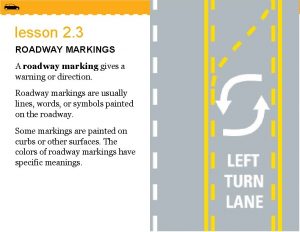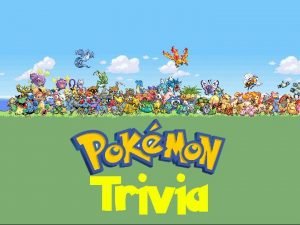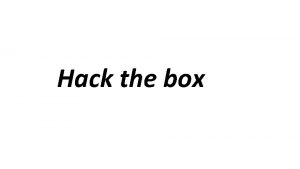Pokemon Yellow Total Control Hack Logan Hood Justin
















![Items to Instruction [62 16 37 224 47 240 37 230 15 55] A Items to Instruction [62 16 37 224 47 240 37 230 15 55] A](https://slidetodoc.com/presentation_image_h/051b2e13c0cc0043cf47689adc7071a7/image-17.jpg)









- Slides: 26

Pokemon Yellow Total Control Hack Logan Hood, Justin Baumgartner CSCE 531 -- 23 April 2013

Overview • • The "total control" hack was performed by Robert Mc. Intyre. By utilizing a buffer overflow bug within the game Pokemon Yellow, he was able to reprogram the game from within by creating a series of "bootstrapping" programs. http: //aurellem. org/vba-clojure/html/totalcontrol. html

Background The Game. Boy, a portable handheld gaming device was released in 1989. Pokemon Yellow was released in 1998 by Nintendo for the Game. Boy.

Game. Boy's Architecture • • • The Game. Boy's machine code is a mix of 8 bit and 16 -bit instructions. Game data is also a series of 8 -bit words. The Game. Boy is a Von Neumann machine i. e. the instructions and the active game data are stored in the same memory unit. An entire game is stored on a ROM (readonly memory) cartridge. The Game. Boy itself has 8 k. B of RAM, plus 8 k. B of VRAM.

Why Pokemon Yellow? • • • A highly popular game with a competitive "speed-running" community. The fastest legitimate run is ~2. 5 hours, but what if we exploit bugs in the game? Some individuals discovered a buffer overflow bug that could allow a player to skip the majority of the game, bringing the completion time of the game under two minutes.

What Is a Buffer Overflow? • Occurs when a program accesses data outside the normal bounds of an array or data structure with size set at run-time. // C++ example -- reading past the "buffer" int array [10]; for (int i=0; i < 10; array[i++]=i); for (int j=0; j <=10; j++) cout << array[j] << " "; 0 1 2 3 4 5 6 7 8 9 134514656

What Is a Buffer Overflow? // writing past the buffer char* input = new char[5]; int* array = new int[10]; for (int j=0; j < 10; array[j] = j++); cout << "enter 5 characters: " << endl; /* if the user enters more than 5 characters, this will cause a buffer overflow */ cin >> input; cout << "here is your unaltered list. . . " << endl; for (int j=0; j < 10; cout << array[j++] << endl);

What Is a Buffer Overflow? enter 5 characters. . . > hello here is your unaltered list. . . 0 1 2 3 4 5. . .

What Is a Buffer Overflow? enter 5 characters. . . > YOU_CAN'T_TELL_ME_WHAT_TO_DO!! here is your unaltered list. . . 1213685573 1415533633 1329880911 8481 4 5. . .

What Is a Buffer Overflow? • • This can be a significant security issue if the compiler and/or operating system does not perform bounds checking. Since there is no "operating system" other than Pokemon Yellow running off the ROM cartridge, all bounds-checking is dependent on the programmer.

How Does This Bug Work? • • • While saving the game, the author kills the game at a very specific time. If timed correctly, the save file will be corrupted so that the game thinks the player has 255 pokemon (normally, the maximum size of this array is 6). The player can perform certain operations on this list, such as swapping the order of pokemon.

How Does This Bug Work? • This list points to blocks of memory (each Pokemon is stored in 30 bytes), so 30 bytes of memory are swapped whenever pokemons' order are switched. 0 1 2 3 4 5 0 -29 30 -59 60 -89 90 -119 120 -149 150 -179

How Does This Bug Work? • So if the bounds of the list are expanded, and we can swap 30 -byte blocks further down the line. . . accessing memory we shouldn't be able to! 0 1 2 3 4 5 6 7 8

Result of Bug • • Now the player can access other memory locations that he shouldn't be able to access. . including the size of the player's inventory, causing another buffer to overflow.

Item List Overflow • • • The advantage of overflowing the inventory array is that this is memory that the player can alter (by changing the order of items, buying items, dropping items, etc. ). Every item in the game has a specific 8 -bit ID, as well as an 8 -bit number for the quantity. For example, "16 lemonades" would be stored as [62 16]

First Step - Item List • • • The author writes his first program in the player's inventory by finding items & quantities that correspond to instructions. A certain function pointer (an address of a subroutine) is also accessible from the overflowed inventory. By altering the value of this pointer to point to the beginning of the inventory, and causing this subroutine to be called, the first program can be executed.
![Items to Instruction 62 16 37 224 47 240 37 230 15 55 A Items to Instruction [62 16 37 224 47 240 37 230 15 55] A](https://slidetodoc.com/presentation_image_h/051b2e13c0cc0043cf47689adc7071a7/image-17.jpg)
Items to Instruction [62 16 37 224 47 240 37 230 15 55] A "program" that reads the current input state and copies it to Register A. It corresponds to this sequence of items: lemonade x 16 guard spec. x 224 leaf stone x 240 guard spec. x 230 parlyz heal x 55

First Step - Item List • • • After buying the correct items and quantities, the author deposits them into the item PC to spell out his first program. Because of the constraints on the number of items available in the game, this program only reads from the A, B, start, and select buttons. With this program, 4 bits can be generated each frame.

Second Step - 4 Button • • This four button program is used to write another program that can take input from each of the 8 buttons on the Game. Boy. This program can write 8 bits each frame so any number of bytes can be written to any location.

Buttons to Instruction • When writing the programs, the buttons are used to determine if each bit is 0 or 1. So for the 8 button program where B, start, and right are pressed: 0 0 0 1 1 0 } 0 x 16

Third Step - 8 Button • • Finally, the author uses bootstraps the new 8 button program to create another program that can also display the bytes it is writing on the screen. The function pointer is swapped with the location of this final program and the program is loaded and run.

Tombstone Diagrams 8 -Button MC 8 -Button 4 -Button MC Items MC MC

Tombstone Diagrams 8 -Button w/ Display 8 -Button MC MC MC

Tombstone Diagrams Target Program 8 -Button MC 8 -Button w/ Display MC MC MC

Video Demonstration https: //www. youtube. com/watch? feature=player_embedded&v=p 5 T 81 y. Hk. Ht. I

What Else Is Possible • • Theoretically any 8 -bit program that can fit on the 8 k. B of memory could be programmed to run in this fashion. Could have Tetris or Pong programmed to run on Pokemon Yellow cartridge.
 Pokemon yellow hack
Pokemon yellow hack Rom hack definition
Rom hack definition Hov
Hov A short section of corrugated roadway
A short section of corrugated roadway Duotrio pokemon
Duotrio pokemon Pokemon eden
Pokemon eden Pokemon weakness chart gen 1
Pokemon weakness chart gen 1 Shakespeare meter
Shakespeare meter Pokemon github.io
Pokemon github.io Pokemon
Pokemon When will oddish evolve
When will oddish evolve Pokemon go chenapan
Pokemon go chenapan Is pokemon a sport
Is pokemon a sport Geometry pokemon
Geometry pokemon Uafir fórmula
Uafir fórmula Total revenues minus total costs equals
Total revenues minus total costs equals Total revenues minus total costs equals
Total revenues minus total costs equals Total revenues minus total costs equals
Total revenues minus total costs equals Total revenue minus total expenses
Total revenue minus total expenses Logan high school athletics
Logan high school athletics Roper logan tierney günlük yaşam aktiviteleri
Roper logan tierney günlük yaşam aktiviteleri Virginia henderson 14 temel gereksinim
Virginia henderson 14 temel gereksinim Logan muller
Logan muller Logan terminal e parking
Logan terminal e parking Logan muller
Logan muller Lars didn't recognize patrick logan because
Lars didn't recognize patrick logan because Uncle hammer quotes
Uncle hammer quotes

















































